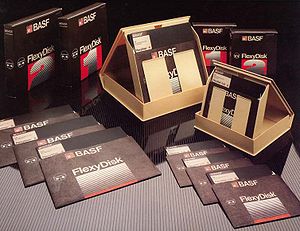Difference between revisions of "Rescuing Floppy Disks"
| Line 6: | Line 6: | ||
None of these options should be considered endorsements, and Archive Team does not earn commission from the sale of these items. | None of these options should be considered endorsements, and Archive Team does not earn commission from the sale of these items. | ||
=== Some Basic Thoughts on Floppy Disks === | |||
There are three different main sizes of floppy disks that had the most traction: | |||
* 8" Disks | |||
* 5 1/4" Disks | |||
* 3 1/2" Disks | |||
8" floppies fell out of favor relatively quickly in favor of the 5 1/4" versions. In the late 1980s, 3 1/2" overtook 5 1/4" as the dominant format, but a lot of machines, such as the Commodore 64, Atari 810, IBM PC, Kaypro, Apple II and II, and a range of others all supported the 5 1/4" primarily. | |||
All floppies work on the same principle: a magnetic disc with a hole in the middle is inside a case, and a disk drive reads the magnetic data off the disc. Some aspects changed - where 8" and 5 1/4" discs had no built-in protection for the magnetic face of the disc except a paper cover, the 3 1/2" versions had a small spring-loaded door that was opened by the disk drive. | |||
Storage could make a huge difference in the lifespan of Floppies, and a pile of disks put inside a box that was stored in a low humidity, non-extreme-temperature environment could last a lot longer than a floppy used constantly that was left on top of a computer monitor for weeks. | |||
We're going to assume you're just trying to take a pile of disks from however far back and transfer the data onto something more recent. In all cases, try and avoid throwing out the original disks after doing transfer, as you might find that the transfer you've done is missing information, or that technology might have shifted in the meantime, allowing better extraction of the data. | |||
Revision as of 12:48, 14 July 2011
While they were cool-looking, convenient and even somewhat inexpensive after a while, Floppy Disks are out as a medium to store data on home computers. The USB stick, wireless access, the use of the internet, and a whole other range of options have rendered this medium obsolete. That said, a situation now exists where there are millions of these things out in the world, some of them containing rare or unusual pieces of history, and so there's a lot of benefit to getting all that old data off that medium.
This page is meant to be a clearinghouse for various options that a person or group of reasonable technical ability could use to rescue data from floppy disks. If any of these options seem daunting, a number of people have offered to accept floppy disks and pull the data using these tools.
None of these options should be considered endorsements, and Archive Team does not earn commission from the sale of these items.
Some Basic Thoughts on Floppy Disks
There are three different main sizes of floppy disks that had the most traction:
- 8" Disks
- 5 1/4" Disks
- 3 1/2" Disks
8" floppies fell out of favor relatively quickly in favor of the 5 1/4" versions. In the late 1980s, 3 1/2" overtook 5 1/4" as the dominant format, but a lot of machines, such as the Commodore 64, Atari 810, IBM PC, Kaypro, Apple II and II, and a range of others all supported the 5 1/4" primarily.
All floppies work on the same principle: a magnetic disc with a hole in the middle is inside a case, and a disk drive reads the magnetic data off the disc. Some aspects changed - where 8" and 5 1/4" discs had no built-in protection for the magnetic face of the disc except a paper cover, the 3 1/2" versions had a small spring-loaded door that was opened by the disk drive.
Storage could make a huge difference in the lifespan of Floppies, and a pile of disks put inside a box that was stored in a low humidity, non-extreme-temperature environment could last a lot longer than a floppy used constantly that was left on top of a computer monitor for weeks.
We're going to assume you're just trying to take a pile of disks from however far back and transfer the data onto something more recent. In all cases, try and avoid throwing out the original disks after doing transfer, as you might find that the transfer you've done is missing information, or that technology might have shifted in the meantime, allowing better extraction of the data.
